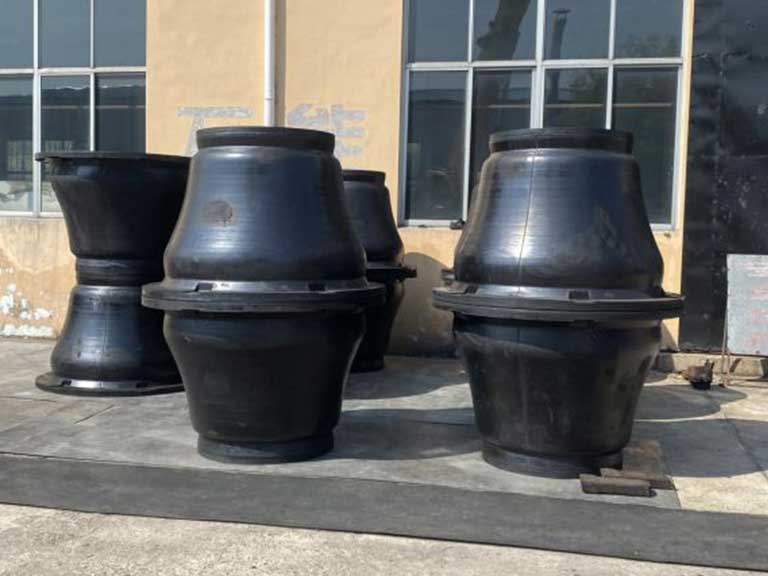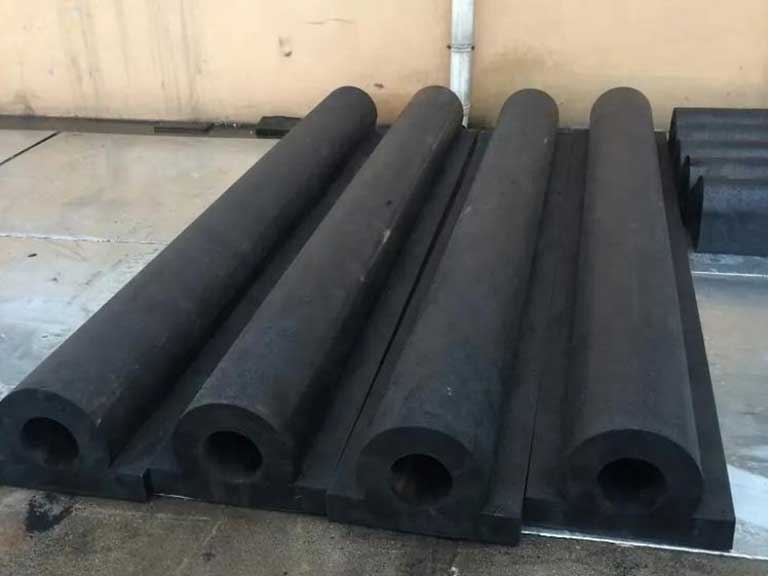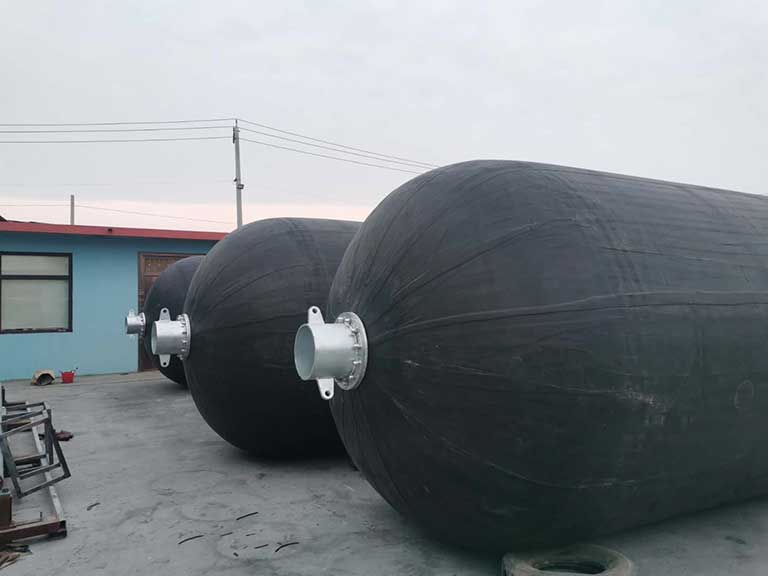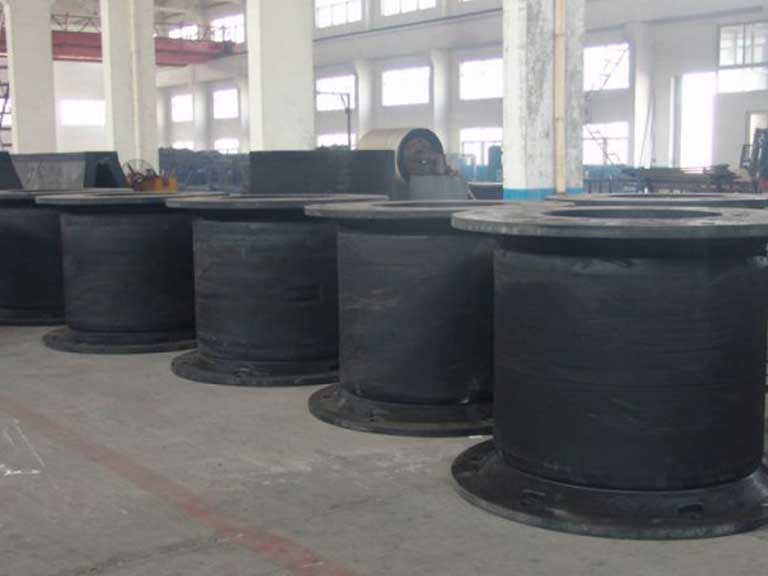Natural and synthetic rubber compounds of high quality are used to make rubber fender. These include Styrene-Butadiene Rubber (SBR), EPDM rubber, and Neoprene (Nitrile). These compounds are often mixed to get certain performance features like elasticity, tear resistance, and resistance to weathering or oils.
Henger Shipping Supplies specializes in manufacturing high-quality marine rubber fenders. These fenders protect ships and docks from damage during collisions or berthing. Our comprehensive guide will explore the various materials used in manufacturing rubber fenders. And how they impact the fenders’ overall performance and service life.
Table of Contents
What Are Rubber Fenders?
Rubber fenders are a type of protective device. Their function is to absorb and dissipate the energy generated during vessel berthing. This mitigates the impact on both the vessel and the berthing structure. Rubber fenders protect against damage by bending and then returning to their original shape.
We have seen how well our high-quality rubber fenders work to stop many possible accidents at shipping terminals and ports all over the world at Henger Shipping Supplies.
Primary Materials Used in Rubber Fenders Made Of
There are many different kinds of materials used to make rubber fenders. Each one was picked because of its unique features that make the fender work better. Choosing these materials is very important for the rubber fender’s longevity, performance, and overall value.
Natural Rubber Compounds
Natural rubber compounds are a key part of making rubber fenders. We use these compounds because they are very elastic and don’t wear down easily. Natural rubber is a great material for absorbing energy during collisions since it is strong and flexible at the same time.
Synthetic Rubber Varieties
There are also synthetic rubber types that can improve the performance of rubber fenders. Synthetic rubbers are better at withstanding heat, oil, and other things in the environment. We add these materials to make sure our fenders can handle tough circumstances at sea.

Reinforcement Materials and Additives
Adding reinforcement materials and additives is very important for making rubber fenders stronger and better at what they do. To make the rubber composite stronger, people often employ cord cloth, steel wire, and polyester. Additives like carbon black and silica fillers also make the material stronger, more resistant to tearing, and more resistant to wear and strain.
| Material | Function | Benefits |
| Natural Rubber | Primary component | Elasticity, abrasion resistance |
| Synthetic Rubber | Enhances performance | Heat, oil, and environmental resistance |
| Carbon Black | Reinforcing agent and UV stabilizer | Tensile strength, tear resistance, UV protection |
| Silica Fillers | Abrasion resistance | Reduces heat buildup, improves durability |
Key Properties of Rubber Fender Materials
The material qualities of rubber fenders are very important for their capacity to handle different nautical conditions. We make our rubber compounds to have certain properties that let them last longer and work better.
Elasticity and Energy Absorption
When a ship is docking or mooring, rubber fenders need to be able to absorb a lot of energy. We do this by using very elastic rubber compounds. This lets fenders bend when they hit anything and then return to their original shape, which absorbs energy very well.

Tensile Strength and Durability
The tensile strength of rubber fender materials is very important for how long they last. We make sure that our fenders have a high tensile strength so that they don’t break or fracture, even in bad weather. This makes them last longer.
Environmental Resistance Capabilities
Rubber fenders are exposed to a number of environmental stresses, including UV radiation, ozone, seawater, and changes in temperature. To make sure rubber fenders work well in all kinds of weather, we employ materials like EPDM, which is very resistant to weathering and ozone, and neoprene, which is very resistant to oil and chemicals.
Manufacturing Processes for Rubber Fenders
To make rubber fenders that last and work well, the production techniques must be quite exact. We use cutting-edge methods at Henger Shipping Supplies to make marine rubber fenders that are of the highest quality.
- Extrusion Process Explained: To make a certain shape, the extrusion process pushes rubber compounds through a die. This method works well for making fenders with cross-sections that are always the same. But it can’t make complicated shapes very well.
- Molding Techniques and Applications: To make complicated rubber fenders, you need to know how to mold them. We make fenders with different cross-sections and specific characteristics using compression molding, transfer molding, and injection molding. For example, D-Type fenders are shaped to make them stronger and last longer.
| Molding Technique | Application | Benefits |
| Compression Molding | Complex geometries, large fenders | High precision, enhanced durability |
| Transfer Molding | Fenders with intricate details | Improved surface finish, reduced defects |
| Injection Molding | High-volume production, precise tolerances | Efficient, cost-effective, consistent quality |
We can produce rubber fenders that fit the needs of each customer by using these innovative molding methods. This guarantees the best performance and longest life.

Types of Rubber Fenders and Their Material Composition
Rubber fenders are available in multiple forms, including cylindrical, pneumatic, and foam-filled types, each with unique material characteristics. Understanding these differences is crucial for selecting the right fender for specific maritime applications.
- Cylindrical and D-Type Fenders: People often employ D-type fenders and cylindrical fenders. Because they are easy to use and work well. They are usually made of solid rubber compounds that are quite strong and can absorb a lot of energy.
- Pneumatic Fenders: Pneumatic fenders are designed for high-energy absorption and are often used in ship-to-ship transfers and between ships and docks. They are made with reinforced rubber that provides flexibility and strength.
- Foam-Filled Fenders: Foam-filled fenders have the best of both worlds: strong rubber exterior skins and closed-cell foam cores. This design makes fender systems that are light, float, and absorb energy very well.
Material Selection Factors for Different Applications
The way rubber fenders are made and what they are made of is very important for how well they can absorb energy and protect ships. Henger Shipping Supplies knows that different uses need different materials to work best.
We think about the size and kind of ships that will be using the fenders. This is because larger ships need fenders that can absorb more energy. The type of vessel also affects the choice of fender material. Because some materials work better with some types of vessels.
In addition, the performance and life of rubber fenders are greatly affected by the weather, such as temperature and exposure to chemicals. We choose materials that can stand up to these conditions, which ensures that the fender will always be protected.
When selecting materials, we carefully consider their performance standards. For example, their energy absorption capacity, load-bearing capability, and flexibility. This makes sure that our fenders can handle the specific needs of specialized activities like ship-to-ship transfers or offshore moorings.

Conclusion
The correct rubber fender material is the most important thing for making shipping safer and lowering expenses. Henger Shipping Supplies can help you select the right fenders, whether standard or custom-made.
FAQ
What are the primary materials used in manufacturing marine fenders?
We utilize a combination of natural and synthetic compounds, reinforced with various materials to enhance durability and performance.
How do I choose the right fender material for my vessel?
The choice depends on several factors, including vessel size and type, environmental conditions, and specific performance requirements. We consider these factors to provide the most suitable solution.
What is the significance of elasticity in fender materials?
Elasticity allows fenders to absorb energy during docking or collisions, reducing the impact on both the vessel and the docking structure. This property is crucial for effective protection.
Can fender materials withstand harsh weather conditions?
Our fender materials are designed to resist various environmental factors, including UV rays, extreme temperatures, and chemical exposure, ensuring they remain effective over time.
Are customization options available for fender solutions?
Yes, we offer customization to meet specific requirements, including varying sizes, shapes, and material compositions, to ensure the fender meets the unique needs of your vessel.




